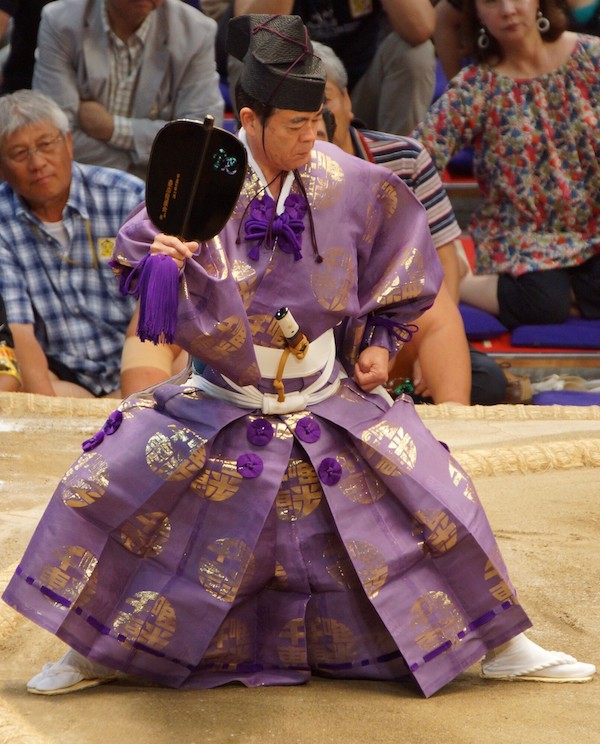
Japan has a rich sporting culture that extends into the modern day. Take baseball as an example. Japan is one of the only places outside the Americas where the sport is popular enough that it’s played at a professional level.
And that’s not the only western sport they’ve imported. The game of golf is likewise popular there.
Although Japan only represents about 1.62% of the global population, it accounts for 22% of the world’s golf economy. So it’s fair to say that Japan is more passionate about sports than most nations.
And that enthusiasm extends to traditional Japanese sports.
But what did athletic contests look like before Japan started importing sports from the west? To answer that, let’s take a look at traditional sporting culture throughout Japan’s history.
Sumo: The Most Venerable of Japanese Sports
If you’re a professional wrestling fan, you may be aware that the western spectacle has been popular in Japan for decades. Japanese stars like Taka Michinoku and the legendary Tiger Mask eventually found their way into western federations. And many western talents like Terry Funk and Mick Foley are household names in Japan.
But there’s a more ancient style of wrestling that’s been part of Japanese tradition for millennia.
Sumo wrestling is, of course, the most internationally famous of Japan’s sports. And for good reason. It’s one of the most ancient sports in the world to still be in practice today.
And although westerners tend to view it as comical, sumo is treated very seriously in its native Japan.
History and Tradition of Sumo
The Nihon Shoki, one of the oldest surviving texts of Japanese history, dates the first sumo match to the year 23 BC. And the sport has persisted, virtually unchanged, ever since.
Part of the reason why the sport refuses to modernize is that it’s not only an athletic contest but a religious rite.
Sumo has its origins in the Shinto religion. Hence the sport, its traditions, and sometimes even its participants are considered sacred. This also explains the amount of ceremony that goes into each match.
Before a match can take place, a Shinto priest ritually purifies the ring with salt. And there is usually a small shrine suspended above the ring, further symbolizing the sport’s religious origin and significance.
This sense of propriety and tradition extends beyond the ring.
Becoming a sumo wrestler isn’t as simple as showing up for a try-out. Rather, the training process is more akin to becoming a monk than a professional athlete.
Apprentice sumo live in stables called heya. Here they spend each day training and learning the rules and customs of their sport. While they are apprenticed, they are generally forbidden from leaving their stable or having contact with the outside world. Every aspect of their life from when they eat, sleep, and train is dictated to them by their coach.
So if you ever wondered how these men become as strong as they are, it’s that religious level of dedication.
The Sumo Contest
Sumo tournaments are only held a few times a year. So if you want to see a match in person, you’ll need to plan your trip accordingly. Don’t delay in buying your tickets, as seats always sell out quickly for this popular spectator sport.
After the ring at a tournament is consecrated, the first match may begin. The two participants will start by placing both hands on the floor before charging at each other.
There are a few ways to win a sumo match.
The first is by pushing an opponent outside the ring. The second is by forcing any part of their body besides the soles of their feet to touch the ground. The third is by disqualification.
A competitor may be disqualified if they lose their mawashi, the loincloth that covers their lower body. And though uncommon, a wrestler may be disqualified if they are knocked out.
This can happen because sumos are taught to lead with their heads. So while deliberate headbutts are not technically a part of the sumo style, they often happen regardless as a consequence of the two men charging each other.
Sumo champions are treated as celebrities in Japan. The highest rank that a sumo wrestler can hope to achieve is that of yokozuna. These men are not only the supreme champions of the sport but become the public face of sumo wrestling in Japan and beyond.
As such, they are held to extremely high standards of conduct and performance. All of their public statements and actions are scrutinized in the press. They are expected to either win or at least be a serious contender in any tournament they take part in.
Kendo: The Way of the Sword
A recurring theme that you’ll notice in famous sports from Japan is an element of martial tradition. And kendo is one of the most notable examples.
Meaning “the way of the sword”, kendo is the most popular of Japan’s many fencing arts and takes its inspiration from the traditions of the samurai. It’s a direct descendant of the more ancient kenjutsu, the primary style of swordplay employed by the samurai.
This martial art uses swords made from either wood or bamboo, rather than live, metal blades. For added safety, practitioners protective armor covering the head, neck, and other vulnerable areas.
In kendo, these two combatants will duel against one another using various styles and techniques. Wins are usually awarded based on the first touch.
Kendo remains one of the most popular sports on an amateur level. Many schools offer it as an elective or optional sport, much like how a western school might have wrestling classes or teams.
Japanese Martial Arts: A World Unto Itself
As touched upon earlier, the history of sports in Japan goes hand-in-hand with the history of Japanese martial arts.
The subject is expansive enough that covering all the popular marital arts in meaningful detail would be enough to fill a college textbook. However, there are a few standout sports that deserve particular mention.
Judo, or “the gentle way”, is the most significant on the international stage. It became world famous thanks to its inclusion in the summer Olympics in 1964. It has been an event at every summer Olympics ever since, except for the 1968 games.
Judo is a descendant of jiu-jitsu, which in turn traces its lineage back to the Nara period. But whereas jiu-jitsu evolved on the battlefield as a form of hand-to-hand combat, judo is considered a safer, less dangerous sport. The grappling art is based on the principle of using an aggressor’s momentum against them to perform various throws and takedowns.
A marital art with a comparable concept to judo is aikido. It likewise has its origins in jiu-jitsu but is even less aggressive than its cousin judo. Traditional aikido has no aggressive maneuvers at all and is instead built around harmlessly deflecting an aggressor’s assaults.
And of course, no discussion of Japanese martial arts is complete without mentioning karate. The word “karate” doesn’t refer to a single style, but rather a whole family of striking arts using the hands and feet. Notable examples include Goju-ryu, Shotokan-ryu, Wado-ryu, and Shito-ryu.
Yabusame: Japanese Equestrianism
Though we tend to imagine the ancient samurai as being footbound swordsmen, in reality, they would only ever draw their swords as a last resort. They much preferred to fight on horseback, armed with a bow.
The modern sport of yabusame is a recreation of this ancient style of combat.
Being able to draw a bow and hit a precious target is already an impressive skill. Being able to ride a horse galloping at full speed is likewise an admirable talent. Doing both at the same time can take years of dedicated practice.
Therin lies the challenge of yabusame.
Much like sumo, yabusame has some religious and cultural connotations in addition to its sporting ones. You’re most likely to see a live demonstration either at a shrine or during certain cultural festivals. But there are a few places in Japan where amateurs can take a class to try their hand at it themselves.
Kemari: Ancient Japanese Recreation
Not all sports in Japan trace their origins back to ways of war. Kemari, literally meaning “kicking ball” is one example of a purely peaceful pastime.
As the name suggests, it bears some resemblance to western soccer. But an important distinction is that kemari is not a competitive sport. Rather, everyone on the field works together.
Players, dressed in the sort of traditional garb usually reserved for Shinto priests, mass together on the playing field. There, they kick a leather ball into the air, with the object being to keep it in the air for as long as possible. Players may use any part of their body except for their hands and arms.
Take In the Traditional Sporting Culture of Japan
Because Japan spent much of its history in a state of isolation, much of its ancient culture has survived to the modern day. That traditional Japanese sports are still practiced with such enthusiasm is indicative of that.
Experiencing these contests in person is a must-see experience for any sports fanatic. So if you’re ready to broaden your horizons, check out this guide on what you can expect from a flight to Japan.
- 12 Things to Do When Visiting Japan - October 7, 2022
- 13 Reasons to Move to Japan - October 7, 2022
- A Guide to Japanese New Year Traditions - October 6, 2022








